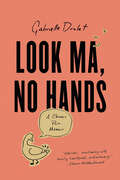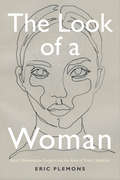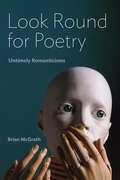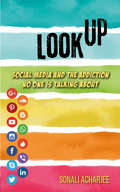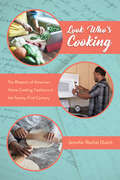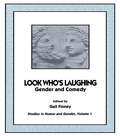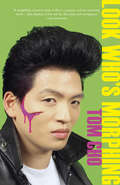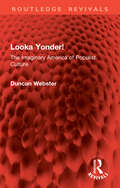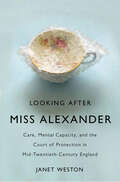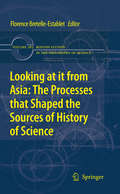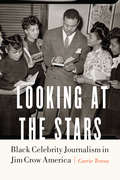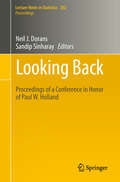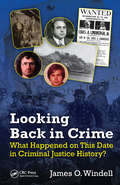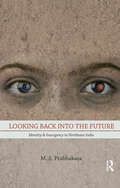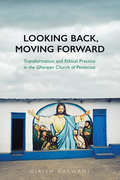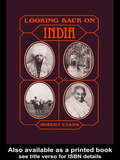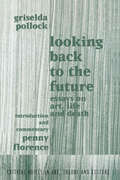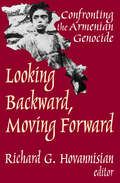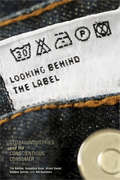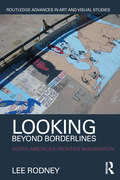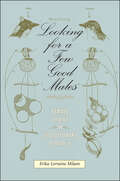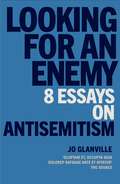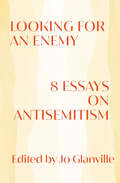- Table View
- List View
Look Ma, No Hands: A Chronic Pain Memoir
by Gabrielle DroletA humorous, profound debut memoir about chronic pain, accessibility, and young adulthood, by an acclaimed essayist and cartoonist.In 2021, Gabrielle Drolet developed a condition that made her unable to use her hands. It only worsened over time, and as a writer and artist, she had to learn new ways of creating and expressing herself. The experience completely changed her life and her outlook. Look Ma, No Hands explores both the difficulty and the humour of developing chronic and life-altering pain in her twenties. Each chapter looks at a different aspect of her life touched by her disability: how she learned to write when she couldn&’t type; how she learned to manage the most mundane daily tasks. She moves cities and as her work as a writer and cartoonist builds has to navigate different byzantine health systems without the privilege or security of having a family doctor, even as she moves into her new apartment and embarks on first dates. And she does all of this with the most wonderful sense of the absurd. Look Ma, No Hands is utterly charming and shares profound reflections on life&’s curveballs, and explores how, in Drolet&’s words, &“you can live a full—even funny—life in a disabled body.&”
The Look of a Woman: Facial Feminization Surgery and the Aims of Trans- Medicine
by Eric PlemonsDeveloped in the United States in the 1980s, facial feminization surgery (FFS) is a set of bone and soft tissue reconstructive surgical procedures intended to feminize the faces of trans- women. While facial surgery was once considered auxiliary to genital surgery, many people now find that these procedures confer distinct benefits according to the different models of sex and gender in which they intervene. Surgeons advertise that FFS not only improves a trans- woman's appearance; it allows her to be recognized as a woman by those who see her. In The Look of a Woman Eric Plemons foregrounds the narratives of FFS patients and their surgeons as they move from consultation and the operating room to post-surgery recovery. He shows how the increasing popularity of FFS represents a shift away from genital-based conceptions of trans- selfhood in ways that mirror the evolving views of what is considered to be good trans- medicine. Outlining how conflicting models of trans- therapeutics play out in practice, Plemons demonstrates how FFS is changing the project of surgical sex reassignment by reconfiguring the kind of sex that surgery aims to change.
The Look of the Past
by Ludmilla JordanovaHow can we use visual and material culture to shed light on the past? Ludmilla Jordanova offers a fascinating and thoughtful introduction to the role of images, objects and buildings in the study of past times. Through a combination of thematic chapters and essays on specific artefacts - a building, a piece of sculpture, a photographic exhibition and a painted portrait - she shows how to analyse the agency and visual intelligence of artists, makers and craftsmen and make sense of changes in visual experience over time. Generously illustrated, and drawing on numerous examples of images and objects from 1600 to the present, this is an essential guide to the skills that students need in order to describe, analyse and contextualise visual evidence. The Look of the Past will encourage readers to think afresh about how they, like people in the past, see and interpret the world around them.
Look Round for Poetry: Untimely Romanticisms (Lit Z)
by Brian McGrathPoetry is dead. Poetry is all around us. Both are trite truisms that this book exploits and challenges.In his 1798 Advertisement to Lyrical Ballads, William Wordsworth anticipates that readers accustomed to the poetic norms of the day might not recognize his experiments as poems and might signal their awkward confusion upon opening the book by looking round for poetry, as if seeking it elsewhere. Look Round for Poetry transforms Wordsworth’s idiomatic expression into a methodological charge. By placing tropes and figures common to Romantic and Post-Romantic poems in conjunction with contemporary economic, technological, and political discourse, Look Round for Poetry identifies poetry’s untimely echoes in discourses not always read as poetry or not always read poetically.Once one begins looking round for poetry, McGrath insists, one might discover it in some surprising contexts. In chapters that spring from poems by Wordsworth, Lucille Clifton, John Keats, and Percy Bysshe Shelley, McGrath reads poetic examples of understatement alongside market demands for more; the downturned brow as a figure for economic catastrophe; Romantic cloud metaphors alongside the rhetoric of cloud computing; the election of the dead as a poetical, and not just a political, act; and poetic investigations into the power of prepositions as theories of political assembly.For poetry to retain a vital power, McGrath argues, we need to become ignorant of what we think we mean by it. In the process we may discover critical vocabularies that engage the complexity of social life all around us.
Look to the Mountain: An Ecology of Indigenous Education
by Gregory CajeteAn important contribution to the body of indigenous cultural knowledge and a way to secure its continuance.
Look Up: Social Media and the Addiction No One Is Talking About
by Sonali AcharjeeIs a text the same as a hug? Can trolling be a full-time career? Is FOMO turning out to be a real psychological threat? Indian millennials have not only embraced the virtual space and all its extensions but are also living the fake reality. We now have the ability to reinvent ourselves online and keep our digital ego on fleek—flirting, preening, posting and filtering our way to a perfect profile. Social media has led to trading our offline family for virtual ones, relationships for app-based affairs and birthday greetings for emojis. This constant interaction with the screen is taking a massive toll on our daily lives. Young adults are risking their lives for the perfect selfie; troll wars and cyber stalkers are driving people to depression; cyber porn, for small-town religious teens, is dangerously becoming an addiction. So where do we draw the line? How much is too much? Are parental controls and restrictions effective? In this book, the author, through a series of real conversations, breaks down the digital revolution of India and seeks to understand why we’ve turned into a society of hashtags, tweets, shares and likes.
Look Who's Cooking: The Rhetoric of American Home Cooking Traditions in the Twenty-First Century (Folklore Studies in a Multicultural World Series)
by Jennifer Rachel DutchHome cooking is a multibillion-dollar industry that includes cookbooks, kitchen gadgets, high-end appliances, specialty ingredients, and more. Cooking-themed programming flourishes on television, inspiring a wide array of celebrity chef–branded goods even as self-described “foodies” seek authenticity by pickling, preserving, and canning foods in their own home kitchens. Despite this, claims that “no one has time to cook anymore” are common, lamenting the slow extinction of traditional American home cooking in the twenty-first century.In Look Who's Cooking: The Rhetoric of American Home Cooking Traditions in the Twenty-First Century, author Jennifer Rachel Dutch explores the death-of-home-cooking narrative, revealing how modern changes transformed cooking at home from an odious chore into a concept imbued with deep meanings associated with home, family, and community.Drawing on a wide array of texts—cookbooks, advertising, YouTube videos, and more—Dutch analyzes the many manifestations of traditional cooking in America today. She argues that what is missing from the discourse around home cooking is an understanding of skills and recipes as a form of folklore. Dutch’s research reveals that home cooking is a powerful vessel that Americans fill with meaning because it represents both the continuity of the past and adaptability to the present. Home cooking is about much more than what is for dinner; it’s about forging a connection to the past, displaying the self in the present, and leaving a lasting legacy for the future.
Look Who's Laugh: Gender and Comedy
by FinneyFirst Published in 1994. Routledge is an imprint of Taylor & Francis, an informa company.
Look Who's Morphing
by Tom ChoFirst published to acclaim in Australia, Look Who's Morphing by Asian Australian writer Tom Cho is a funny, fantastical, often outlandish collection of stories firmly grounded in popular culture.<P><P> Often with his family, the book's central character undergoes a series of startling physical transformations, shape-shifting through figures drawn from film and television, music and books, porn flicks and comics. He is Godzilla, a Muppet, a gay white male stud, and Whitney Houston's bodyguard; the Fonz, a robot, the von Trapp family's caretaker, a Ford Bronco 4x4--and in the book's lavish climax, a one-hundred-foot-tall guitar-wielding rock star performing for an adoring troupe of fans in Tokyo.Throughout the stories, there is a pervasive questioning of the nature of identity, whether cultural, racial, sexual, gender, or all of the above, and the way it is constructed in a world filled with the white noise of pop culture. Look Who's Morphing is a stylish, highly entertaining literary debut in which nothing--not even one's body--can be taken for granted.Tom Cho is a trans writer who began writing fiction in his mid teens in Australia, where he was influenced by the YA series Sweet Valley High. His stories have appeared in publications in Australia and elsewhere, and he has performed at events and festivals around the world, including in the award-winning show Hello Kitty, which combines literature with power ballads. Look Who's Morphing is his first book.
Looka Yonder!: The Imaginary America of Populist Culture (Routledge Revivals)
by Duncan WebsterFrom Reagan and the New Right to Thatcherism, from the success of Bruce Springsteen to the popularity of the Sun, populism is one of the central questions of the 1980s. First published in 1988, Looka Yonder! analyses the important and ambivalent terrain of American populism across a range of cultural forms, historical traditions, and political events. The book discusses the contradictory nature of these traditions, looking at the historical echoes of the 1890s Populists and the 1930s New Deal in the farm crisis of the 1980s. It suggests that a monolithic view of ‘America’ misses seeing the struggles over traditions and values, with Reagan trying to appropriate Bruce Springsteen, and with opposition to the radical right asserting their claim to national symbols and values.The range of references and readings takes us across periods, genres, and forms, discussing Willa Cather and Sissy Spacek, Sam Shepard and Martin Scorsese, Raymond Carver, Bobbie Ann Mason and Jayne Anne Philips, Elmore Leonard, George V. Higgins and David Mamet, Steinbeck, and Tom Waits. With equal weight given to literary traditions and to popular culture, this book will appeal to students of American culture and to those who enjoy the energy of American films, fiction, and music.
Looking After Miss Alexander: Care, Mental Capacity, and the Court of Protection in Mid-Twentieth-Century England
by Janet WestonIn July 1939, at the Royal Courts of Justice in London, fifty-nine-year-old Beatrice Alexander was found incapable of managing her own property and affairs. Although Alexander and those living with her insisted that she was perfectly well, the official solicitor took control of her home and money, evicted her “friends,” and hired a live-in companion to watch over her. Alexander remained legally incapable for the next thirty years. In the mid-twentieth century, Alexander was one of about thirty thousand people in England and Wales who were, at any time, legally “incapable” and under the auspices of what is now the Court of Protection. Focusing on the period between the 1920s and the 1960s, Looking After Miss Alexander explains the workings of the court, using Alexander’s unusual case to consider the complexities of this aspect of mental health law. Drawing on Court of Protection archives – some of which were made publicly available for the first time in 2019 – and micro-historical methods, Janet Weston also highlights the role of chance, subjectivity, and uncertainty in shaping how events unfolded then, and the stories we tell about those events today.An engaging and accessible history of mental capacity law, Looking After Miss Alexander examines ideas of citizenship and welfare, gender and vulnerability, care and control, and the role of the state. It also offers reflections on historical research and writing itself.
Looking at it from Asia: the Processes that Shaped the Sources of History of Science
by Karine Chemla Agathe Keller Christine Proust Catherine Jami Florence Bretelle-EstabletThe idea of this volume took shape within a group of scholars working on the history of science in Asia. Despite the great differences in time, locations and disciplines between our respective fields of research, we all faced similar situations: among the huge mass of written documents available to historians and that were eventually taken as sources in the historiography of science, some had been well studied while others had been dismissed or ignored. This observation will seem obvious to historians, whose daily work consists in shaping corpuses to raise new questions. The diagnosis has long been established that such selections related to the historians' agenda and thereby reflected the ways in which historiography somehow belonged to its time. Yet, it appeared to us that this diagnosis was insufficient and that the selective consideration of source material was also at least partly related to mechanisms of selection that occurred upstream from the historian's classical work of shaping a corpus. Therefore, we came to the idea that, in order to write, or to rewrite, chapters in the history of science, historians may benefit from relying on a critical analysis of the factors that, along history, shaped the documents that have become their sources or the collections from which they constitute their corpuses. It is to the development of such a branch of critical analysis in the history of science, to its methods and to its benefits --to be illustrated in carefully chosen case studies--, that we suggest to devote a collective research and a book. We want to inquire into how the corpuses we form incorporate long sequences of selections and reorganizations that took place in history and that must be brought to light if we do not want various types of actors of the past to carve their choices and conceptions into our questions and conclusions.
Looking at the Stars: Black Celebrity Journalism in Jim Crow America
by Carrie TeresaAs early as 1900, when moving-picture and recording technologies began to bolster entertainment-based leisure markets, journalists catapulted entertainers to godlike status, heralding their achievements as paragons of American self-determination. Not surprisingly, mainstream newspapers failed to cover black entertainers, whose “inherent inferiority” precluded them from achieving such high cultural status. Yet those same celebrities came alive in the pages of black press publications written by and for members of urban black communities. In Looking at the Stars Carrie Teresa explores the meaning of celebrity as expressed by black journalists writing against the backdrop of Jim Crow–era segregation. Teresa argues that journalists and editors working for these black-centered publications, rather than simply mimicking the reporting conventions of mainstream journalism, instead framed celebrities as collective representations of the race who were then used to symbolize the cultural value of artistic expression influenced by the black diaspora and to promote political activism through entertainment. The social conscience that many contemporary entertainers of color exhibit today arguably derives from the way black press journalists once conceptualized the symbolic role of “celebrity” as a tool in the fight against segregation. Based on a discourse analysis of the entertainment content of the period’s most widely read black press newspapers, Looking at the Stars takes into account both the institutional perspectives and the discursive strategies used in the selection and framing of black celebrities in the context of Jim Crowism.
Looking Back
by Neil J. Dorans Sandip SinharayIn 2006, Paul W. Holland retired from Educational Testing Service (ETS) after a career spanning five decades. In 2008, ETS sponsored a conference, Looking Back, honoring his contributions to applied and theoretical psychometrics and statistics. Looking Back attracted a large audience that came to pay homage to Paul Holland and to hear presentations by colleagues who worked with him in special ways over those 40+ years. This book contains papers based on these presentations, as well as vignettes provided by Paul Holland before each section. The papers in this book attest to how Paul Holland's pioneering ideas influenced and continue to influence several fields such as social networks, causal inference, item response theory, equating, and DIF. He applied statistical thinking to a broad range of ETS activities in test development, statistical analysis, test security, and operations. The original papers contained in this book provide historical context for Paul Holland's work alongside commentary on some of his major contributions by noteworthy statisticians working today.
Looking Back in Crime: What Happened on This Date in Criminal Justice History?
by James O. WindellJust as people are captivated by murder mysteries, detective stories, and legal shows, they are also compulsively interested in the history of criminal justice. Looking Back in Crime: What Happened on This Day in Criminal Justice History? features a treasure trove of important dates and significant events in criminal justice history.Offering hundre
Looking Back into the Future: Identity and Insurgency in Northeast India
by M. S. PrabhakaraThe book examines questions of identity, ethnicity, sovereignty and insurgency in northeastern India, and especially on Assam and its neighbourhood. Written by an academic-journalist, the various articles situate these in their larger social, economic, political and, above all, historical context, the last being especially important in their becoming a part of colonial India relatively late, well after colonial control was established in the rest of India. Based on close, ground level experience involving extensive travel and interaction with the people, this collection is the result of a long journalistic career spanning nearly 50 years in the northeast region. Written in simple, lucid language, the essays cover a range of themes including culture, belief, and identity; homeland and language politics; and insurgency and separatism. The volume also achieves a uniquely dual historical value – while the articles themselves include a lot of historical information tracing the roots of the various issues discussed, the articles themselves range from 1974 to 2010, providing the modern reader with a series of historical moments captured in their immediacy. Of interest to students, academics, researchers in politics, peace & conflict studies, politics, sociology, history, language, those interested in northeast India, policy-makers, cultural studies, etc.
Looking Back, Moving Forward
by Girish DaswaniHow do Ghanaian Pentecostals resolve the contradictions of their own faith while remaining faithful to their religious identity? Bringing together the anthropology of Christianity and the anthropology of ethics, Girish Daswani's Looking Back, Moving Forward investigates the compromises with the past that members of Ghana's Church of Pentecost make in order to remain committed Christians.Even as church members embrace the break with the past that comes from being "born-again," many are less concerned with the boundaries of Christian practice than with interpersonal questions - the continuity of suffering after conversion, the causes of unhealthy relationships, the changes brought about by migration - and how to deal with them. By paying ethnographic attention to the embodied practices, interpersonal relationships, and moments of self-reflection in the lives of members of the Church of Pentecost in Ghana and amongst the Ghanaian diaspora in London, Looking Back, Moving Forward explores ethical practice as it emerges out of the questions that church members and other Ghanaian Pentecostals ask themselves.
Looking Back on India
by Hubert EvansHubert Evans' fascinating memior recounts his time in India and the people and events which shaped the history of the subcontinent. A must read for anyone interested in the history of India and the inner workings of the Raj.
Looking Back to the Future: 1990-1970 (Critical Voices in Art, Theory and Culture)
by Griselda PollockFirst Published in 2000. Routledge is an imprint of Taylor & Francis, an informa company.
Looking Backward, Moving Forward: Confronting the Armenian Genocide
by Richard G. HovannisianThe decades separating our new century from the Armenian Genocide, the prototype of modern-day nation-killings, have fundamentally changed the political composition of the region. Virtually no Armenians remain on their historic territories in what is today eastern Turkey. The Armenian people have been scattered about the world. And a small independent republic has come to replace the Armenian Soviet Socialist Republic, which was all that was left of the homeland as the result of Turkish invasion and Bolshevik collusion in 1920. One element has remained constant. Notwithstanding the eloquent, compelling evidence housed in the United States National Archives and repositories around the world, successive Turkish governments have denied that the predecessor Young Turk regime committed genocide, and, like the Nazis who followed their example, sought aggressively to deflect blame by accusing the victims themselves.This volume argues that the time has come for Turkey to reassess the propriety of its approach, and to begin the process that will allow it move into a post-genocide era. The work includes "Genocide: An Agenda for Action," Gijs M. de Vries; "Determinants of the Armenian Genocide," Donald Bloxham; "Looking Backward and Forward," Joyce Apsel; "The United States Response to the Armenian Genocide," Simon Payaslian; "The League of Nations and the Reclamation of Armenian Genocide Survivors," Vahram L. Shemmassian; "Raphael Lemkin and the Armenian Genocide," Steven L. Jacobs; "Reconstructing Turkish Historiography of the Armenian Massacres and Deaths of 1915," Fatma Muge Go;cek; "Bitter-Sweet Memories; "The Armenian Genocide and International Law," Joe Verhoeven; "New Directions in Literary Response to the Armenian Genocide," Rubina Peroomian; "Denial and Free Speech," Henry C. Theriault; "Healing and Reconciliation," Ervin Staub; "State and Nation," Raffi K. Hovannisian.
Looking behind the Label
by Gustavo Setrini Tim Bartley Sebastian Koos Hiram Samel Nik SummersWhat does it mean when consumers "shop with a conscience" and choose products labeled as fair or sustainable? Does this translate into meaningful changes in global production processes? To what extent are voluntary standards implemented and enforced, and can they really govern global industries? Looking behind the Label presents an informative introduction to global production and ethical consumption, tracing the links between consumers' choices and the practices of multinational producers and retailers. Case studies of several types of products--wood and paper, food, apparel and footwear, and electronics--are used to reveal what lies behind voluntary rules and to critique predominant assumptions about ethical consumption as a form of political expression.
Looking Beyond Borderlines: North America's Frontier Imagination (Routledge Advances in Art and Visual Studies)
by Lee RodneyAmerican territorial borders have undergone significant and unparalleled changes in the last decade. They serve as a powerful and emotionally charged locus for American national identity that correlates with the historical idea of the frontier. But the concept of the frontier, so central to American identity throughout modern history, has all but disappeared in contemporary representation while the border has served to uncomfortably fill the void left in the spatial imagination of American culture. This book focuses on the shifting relationship between borders and frontiers in North America, specifically the ways in which they have been imaged and imagined since their formation in the 19th century and how tropes of visuality are central to their production and meaning. Rodney links ongoing discussions in political geography and visual culture in new ways to demonstrate how contemporary American borders exhibit security as a display strategy that is resisted and undermined through a variety of cultural practices.
Looking for a Few Good Males: Female Choice in Evolutionary Biology (Animals, History, Culture)
by Erika L. Milam2010 Outstanding Academic Title, Choice MagazineWhy do female animals select certain mates, and how do scientists determine the answer? In considering these questions, Erika Lorraine Milam explores the fascinating patterns of experiment and interpretation that emerged as twentieth-century researchers studied sexual selection and female choice. Approaching the topic from both biological and animal-studies perspectives, Milam not only presents a broad history of sexual selection—from Darwin to sociobiology—but also analyzes the animal-human continuum from the perspectives of sex, evolution, and behavior. She asks how social and cultural assumptions influence human-animal research and wonders about the implications of gender on scientific outcomes. Although female choice appears to be a straightforward theoretical concept, the study of sexual selection has been anything but simple. Scientists in the early twentieth century investigated female choice in animals but did so with human social and sexual behavior as their ultimate objective. By the 1940s, evolutionary biologists and population geneticists shifted their focus, studying instead how evolution affected natural animal populations. Two decades later, organismal biologists once again redefined the investigation of sexual selection as sociobiology came to dominate the discipline.Outlining the ever-changing history of this field of study, Milam uncovers lost mid-century research programs and finds that the discipline did not languish in the decades between Darwin’s theory of sexual selection and sociobiology, as observers commonly believed. Rather, population geneticists, ethologists, and organismal biologists alike continued to investigate this important theory throughout the twentieth century.
Looking for an Enemy: 8 Essays on Antisemitism
by Jo Glanville<p>"Like all the best meetings of Jewish minds, this book will make you think, argue and see the world anew." Hadley Freeman, author of House of Glass<p> <p>Conspiracy theories about Jews are back in the mainstream. The Pittsburgh gunman who murdered 11 people in a synagogue claimed that 'filthy evil' Jews were bringing 'filthy evil' Muslims into America. The billionaire philanthropist George Soros has been accused of supporting 'white genocide'. Labour Party members have claimed that Israel is behind ISIS.<p> <p>The belief that Jews are plotting against society never dies, it just adapts to suit the times: from medieval accusations that Jews murder Christians for their blood to claims that Zionists are seeking to control the world.<p> <p>In eight short essays, edited by Jo Glanville, this book goes back to the source of the conspiracy theories and traces their journey into the 21st century in a bid to make sense of their survival.<p> <p>With contributions from some of the great Jewish writers and thinkers of our time, including Tom Segev, Jill Jacobs and Mikhail Grynberg, this is a fresh take on the roots of antisemitism that explores how an irrational belief can still flourish in a supposedly rational age.<p>
Looking for an Enemy: 8 Essays on Antisemitism
by Jo GlanvilleGreat Jewish thinkers offer salient historical commentary on the roots of antisemitism and its contemporary resurgence. From medieval accusations that Jews murder Christians for their blood to the far-right conspiracy theories animating present-day political discourse, it’s clear that the belief that Jews are plotting against society never dies—it just adapts to suit the times. In eight illuminating essays from brilliant Jewish writers and thinkers, Looking for an Enemy offers an urgent, profound take on the experience of antisemitism and its historical context. In order to present a nuanced, global understanding of antisemitism, editor Jo Glanville solicited essays from writers across a wide spectrum of ages, political ideologies, and nationalities. American rabbi Jill Jacobs and respected Israeli historian Tom Segev explore the thorny question of antisemitism in politics. British journalist Daniel Trilling investigates how antisemitism drives far-right extremism, while author Philip Spencer rethinks the forms that antisemitism takes on the left. Polish writer Mikolaj Grynberg reflects on a childhood shadowed by the trauma of the Holocaust; journalist Natasha Lehrer and novelist Olga Grjasnowa explore the culture of antisemitism, and the forces behind it, in France and Germany. In her own contribution, Glanville searches for the historical roots of this dangerous hatred. In moving memoir, rich history, and incisive political commentary, these essays navigate the complex differences in each country’s relationship to its Jewish citizens and reveal the contemporary face of antisemitism. Eye-opening and evocative, Looking for an Enemy explores how an irrational belief can still flourish in a supposedly rational age.
